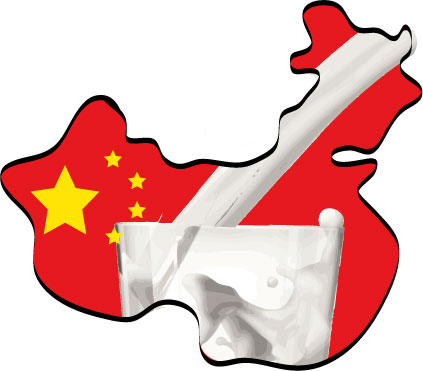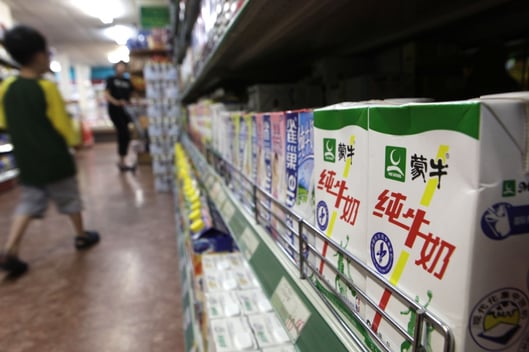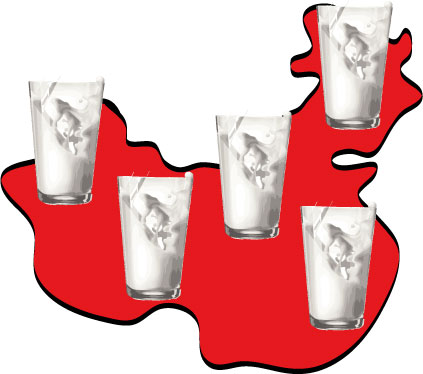According to the OECD-FAO Agricultural Outlook 2014-2023, “world milk production is projected to increase by 180 Mt by 2023 when compared to the base years (2011-2013), the majority of which, 78%, is anticipated to come from developing countries”.
This increase particularly obeys to the rise of population and its income, followed by the expanding popularity and demand of dairy products, mainly due to a westernalisation of consumer preferences and diets in developing countries.
Already in 2012, the USA was the world leader producing almost 91 Mt, followed by India with 54Mt and China producing nearly 38Mt. Brazil held the 4th and Germany the 5th position in the ranking by producing respectively 32.3Mt and 30.5Mt, respectively.
 In the next decade, India is foreseen to outrun the EU and become the greatest milk world producer. At present however, nearly the whole production in India is consumed fresh and further processing is carried out only in small quantities as the country’s processing industry is limited compared to the vast amount of raw milk produced per year.
In the next decade, India is foreseen to outrun the EU and become the greatest milk world producer. At present however, nearly the whole production in India is consumed fresh and further processing is carried out only in small quantities as the country’s processing industry is limited compared to the vast amount of raw milk produced per year.
Compared to India, China, has a smaller production and consumption of milk and other dairy products, but China is showing to be an important player in the international dairy market. Although this market has traditionally been dominated by the leading dairies Nestlé (28.3 billion USD, 2013 turnover), Danone (20.2 billion USD), or Lactalis among others (19.4 billion USD), according to RaboBank, in 2014 the Chinese giant dairy processors Yili and Mengniu increased their sales by 14% and 20% respectively. Yili (7.6 billion USD) has thus entered for the first time the top 10 global rank of dairy brands, right after the USA 9th position Dean Foods (8.6 billion USD).
During the last thirty years, the Chinese dairy production as well as its consumption has enormously risen producing, in 2012, nearly 38 Mt of milk, with circa 12% average of annual growth since 2000.
Initially, milk was produced by small scattered milk farmers but after the year 2000, the country experienced a fast milk output increase together with a ferocious dairy companies’ competition. A wide number of new dairy products were introduced and the biggest dairies started to enlarge their supply chains acquiring milk from other regions than those traditionally dairy. Thus the sector’s consolidation grew where small farmers and dairy processors started to disappear. By 2006, the four giant privately held domestic dairies (such as Yili or Mengniu) represented almost 50% of all dairy sales, being the other half more than 700 smaller dairies. In spite of the consolidation process, more than 80% of the Chinese dairy farms breeded less than 5 cows.
 Due to the lack of cold storage or refrigeration facilities, the dairy sector was initially dominated by the powdered milk market although its consumption remained low. The market changed when the UHT processing technology was introduced, allowing an easy and proper storage as well as a transport of milk without a cold chain and a long shelf life of this commodity.
Due to the lack of cold storage or refrigeration facilities, the dairy sector was initially dominated by the powdered milk market although its consumption remained low. The market changed when the UHT processing technology was introduced, allowing an easy and proper storage as well as a transport of milk without a cold chain and a long shelf life of this commodity.
The growing demand of milk and its consequent output increase turned out to a rabid competition among dairies, where the largest processors strained prices downwards throughout the supply chain. Thus adulteration problems started to occur by adding water and other substances, culminating this practice with the well-known melamine scandal in 2008, where six infants died and nearly 300.000 infants were intoxicated.
The melamine scandal led to the turning point of the dairy industry in China as milk consumption fell for the first time since the late nineties. Predictably, the scandal dramatically changed the consumers’ faith in national dairy products opening great business opportunities to foreign industries. Higher and middle class Chinese families chose imported products, despite the greater prices, rather than domestic products, especially infant formula.
Even if the large processors and traders were shown to be responsible for the melamine scandal, the Government’s reaction was to further promote the consolidation process by promoting larger-scale models throughout the entire dairy chain, from production to marketing, hence forcing many small producers out of the dairy trade. Dairy production processes were standardized being one of this policy’s main purpose to enforce food safety measures in order to reestablish the consumers’ confidence.
 Milk and milk product imports grew however very fast, especially infant formula and milk powder, as food safety issues have dramatically altered the Chinese consumer choices who prefer foreign products. As a result, foreign companies such as Mead Johnson or Nestle’s Wyeth represented more than 40% of the Chinese market of infant formula. On the other hand, and in order to attract those consumers, some Chinese companies even adopted “foreign names” for their domestic products and brands, others decided to establish their processing plants abroad. In addition, since 2009, imports of foreign cows are as well increasing as they produce nearly double the milk of Chinese breeds. This is furthering as well the growth of imports of feed and the use of antibiotics.
Milk and milk product imports grew however very fast, especially infant formula and milk powder, as food safety issues have dramatically altered the Chinese consumer choices who prefer foreign products. As a result, foreign companies such as Mead Johnson or Nestle’s Wyeth represented more than 40% of the Chinese market of infant formula. On the other hand, and in order to attract those consumers, some Chinese companies even adopted “foreign names” for their domestic products and brands, others decided to establish their processing plants abroad. In addition, since 2009, imports of foreign cows are as well increasing as they produce nearly double the milk of Chinese breeds. This is furthering as well the growth of imports of feed and the use of antibiotics.
As a consequence of its whole restructuring and consolidation process, the Chinese dairy industry is nowadays facing new challenges: it seems headed to the US agribusiness model of Concentrated Animal Feeding Operations (CAFOs) where, according to the US EPA, animals are kept and raised in confined situations. In this context, how will the many small-scale producers of more than 50% of raw milk get on with this process? Moreover, how will the Chinese Government deal with the increase of environmental consequences, such as non-point source pollution, or public health problems like antibiotic resistance due to the overuse of antibiotics by the industry?
These and other questions should be treated globally as a common concern to industrialized countries. In addition, as the dairy consumption in China is expected to grow almost 40% by 2022, it will be necessary to look ahead its further impacts on the global market.
